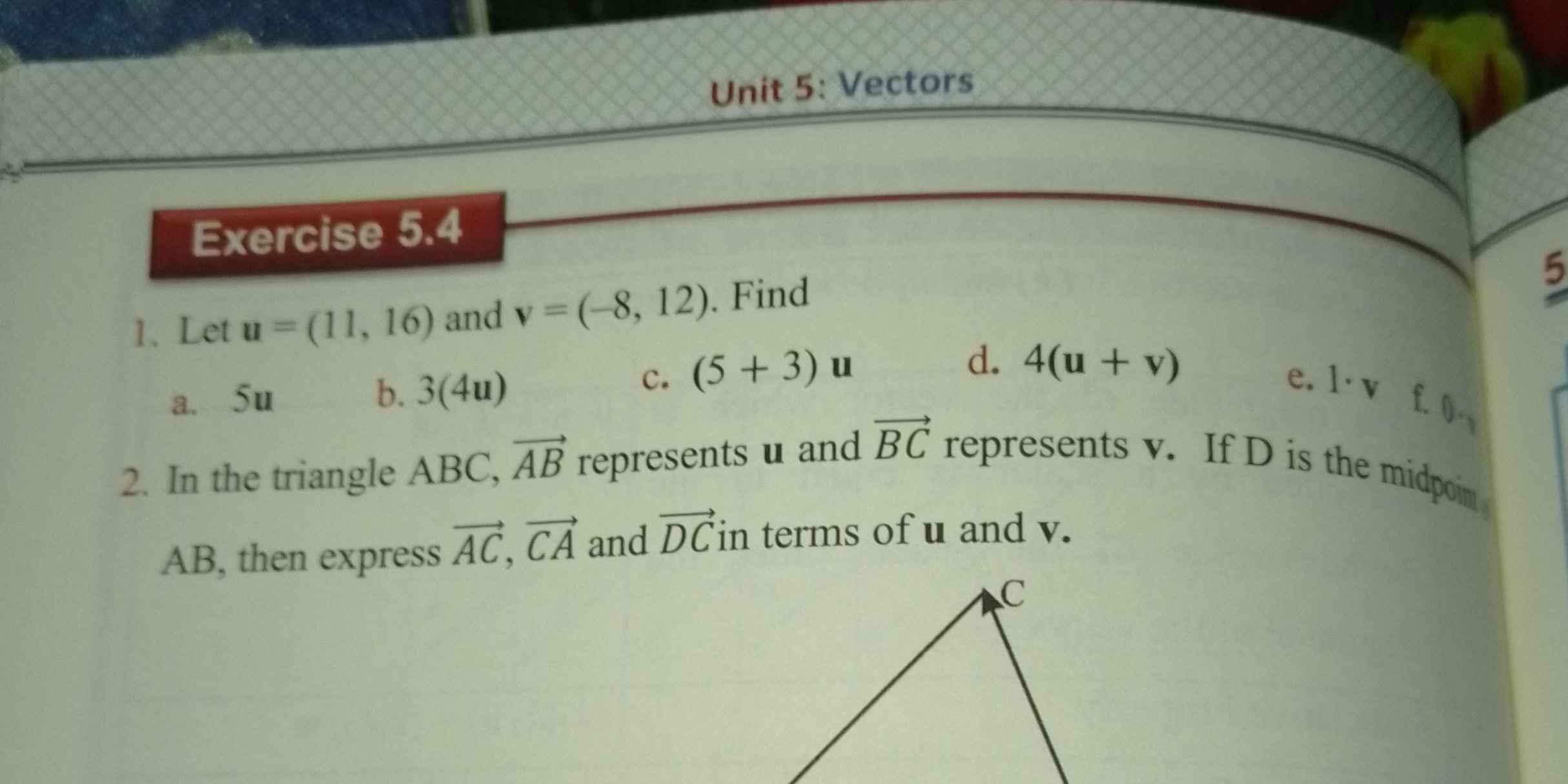1. Let u = (11, 16) and v = (-8, 12). Find: a. 5u b. 3(4u) c. (5 + 3) u d. 4(u + v) e. 1*v f. 0*v 2. In the triangle ABC, AB represents u and BC represents v. If D is the midpoint... 1. Let u = (11, 16) and v = (-8, 12). Find: a. 5u b. 3(4u) c. (5 + 3) u d. 4(u + v) e. 1*v f. 0*v 2. In the triangle ABC, AB represents u and BC represents v. If D is the midpoint of AB, then express AC, CA and DC in terms of u and v.

Understand the Problem
The question is asking you to solve vector related problems. Question #1 asks you to perform scalar multiplication and vector addition. Question #2 is asking to express vector sums based on the geometric relationships in a given triangle.
Answer
1. a. $(55, 80)$ b. $(132, 192)$ c. $(88, 128)$ d. $(12, 112)$ e. $(-8, 12)$ f. $(0, 0)$ 2. $\overrightarrow{AC} = u + v$ $\overrightarrow{CA} = -u - v$ $\overrightarrow{DC} = \frac{1}{2}u + v$
Answer for screen readers
a. $5u = (55, 80)$ b. $3(4u) = (132, 192)$ c. $(5 + 3)u = (88, 128)$ d. $4(u + v) = (12, 112)$ e. $1 \cdot v = (-8, 12)$ f. $0 \cdot v = (0, 0)$ 2. $\overrightarrow{AC} = u + v$ $\overrightarrow{CA} = -u - v$ $\overrightarrow{DC} = \frac{1}{2}u + v$
Steps to Solve
- Compute 5u
Multiply the vector $u = (11, 16)$ by the scalar 5.
$5u = 5 * (11, 16) = (5 * 11, 5 * 16) = (55, 80)$
- Compute 3(4u)
First compute 4u: $4u = 4 * (11, 16) = (4 * 11, 4 * 16) = (44, 64)$
Now compute 3(4u): $3(4u) = 3 * (44, 64) = (3 * 44, 3 * 64) = (132, 192)$
- Compute (5 + 3)u
First, simplify the scalar part: $5 + 3 = 8$
Now compute 8u: $8u = 8 * (11, 16) = (8 * 11, 8 * 16) = (88, 128)$
- Compute 4(u + v)
First, compute u + v: $u + v = (11, 16) + (-8, 12) = (11 + (-8), 16 + 12) = (3, 28)$
Now compute 4(u + v): $4(u + v) = 4 * (3, 28) = (4 * 3, 4 * 28) = (12, 112)$
- Compute 1 * v
Multiply the vector $v = (-8, 12)$ by the scalar 1. $1 * v = 1 * (-8, 12) = (-8, 12)$.
- Compute 0 * v
Multiply the vector $v = (-8, 12)$ by the scalar 0. $0 * v = 0 * (-8, 12) = (0, 0)$.
- Express $\overrightarrow{AC}$ in terms of u and v
Since $\overrightarrow{AB} = u$ and $\overrightarrow{BC} = v$, and using the triangle law of vector addition, we have: $\overrightarrow{AC} = \overrightarrow{AB} + \overrightarrow{BC} = u + v$
- Express $\overrightarrow{CA}$ in terms of u and v
Since $\overrightarrow{AC} = u + v$, then $\overrightarrow{CA} = - \overrightarrow{AC}$: $\overrightarrow{CA} = -(u + v) = -u - v$
- Express $\overrightarrow{DC}$ in terms of u and v
Since D is the midpoint of AB, $\overrightarrow{AD} = \frac{1}{2} \overrightarrow{AB} = \frac{1}{2}u$. Then, $\overrightarrow{DC} = \overrightarrow{DA} + \overrightarrow{AC}$. Since $\overrightarrow{DA} = - \overrightarrow{AD} = - \frac{1}{2}u$, and $\overrightarrow{AC} = u + v$: $\overrightarrow{DC} = - \frac{1}{2}u + (u + v) = \frac{1}{2}u + v$
a. $5u = (55, 80)$ b. $3(4u) = (132, 192)$ c. $(5 + 3)u = (88, 128)$ d. $4(u + v) = (12, 112)$ e. $1 \cdot v = (-8, 12)$ f. $0 \cdot v = (0, 0)$ 2. $\overrightarrow{AC} = u + v$ $\overrightarrow{CA} = -u - v$ $\overrightarrow{DC} = \frac{1}{2}u + v$
More Information
Vector operations like scalar multiplication and vector addition follow specific rules. Scalar multiplication involves multiplying each component of the vector by the scalar. Vector addition involves adding the corresponding components of the vectors. Geometric relationships in triangles can be expressed using vector addition, especially when sides are represented as vectors.
Tips
A common mistake is incorrectly performing scalar multiplication or vector addition, such as forgetting to multiply each component of the vector by the scalar or adding the wrong components of different vectors. Another mistake is sign errors when dealing with vectors that are in opposite directions.
AI-generated content may contain errors. Please verify critical information